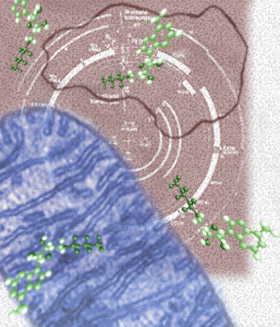Concept 30 Higher cells incorporate an ancient chromosome.

In addition to the set of chromosomes found in the nucleus, a different type of chromosome is found in the energy-generating organelles of the cytoplasm, the mitochondria. The mitochondrial (mt) chromosome contains genes involved in the process of oxidative phosphorylation — the production and storage of energy. There is evidence that mitochondria once existed as free-living bacteria, which were taken up by primitive ancestors of eukaryotic cells. The primitive host cell provided a ready source of energy-rich nutrients, and the mitochondrion provided a means to extract energy using oxygen. This symbiotic relationship became key to survival, as oxygen accumulated in the primitive atmosphere.
Mitochondria are physically similar in size to bacteria, and the mt genome retains bacteria-like features. Like bacterial chromosomes, the mt genome is a circular molecule. Also, very few introns are found in mt genes. Plants contain an additional ancient chromosome in the chloroplasts, which were also absorbed as symbionts.
 DNA is packaged in a chromosome.
DNA is packaged in a chromosome. Higher cells incorporate an ancient chromosome.
Higher cells incorporate an ancient chromosome. Some DNA does not encode protein.
Some DNA does not encode protein. Some DNA can jump.
Some DNA can jump. Genes can be turned on and off.
Genes can be turned on and off. Genes can be moved between species.
Genes can be moved between species. DNA responds to signals from outside the cell.
DNA responds to signals from outside the cell. Different genes are active in different kinds of cells.
Different genes are active in different kinds of cells. Master genes control basic body plans.
Master genes control basic body plans. Development balances cell growth and death.
Development balances cell growth and death. A genome is an entire set of genes.
A genome is an entire set of genes. Living things share common genes.
Living things share common genes. DNA is only the beginning for understanding the human genome.
DNA is only the beginning for understanding the human genome.